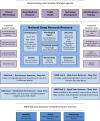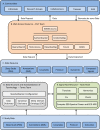Scaling Up Scientific Discovery in Sleep Medicine: The National Sleep Research Resource
- PMID: 27070134
- PMCID: PMC4835314
- DOI: 10.5665/sleep.5774
Scaling Up Scientific Discovery in Sleep Medicine: The National Sleep Research Resource
Abstract
Professional sleep societies have identified a need for strategic research in multiple areas that may benefit from access to and aggregation of large, multidimensional datasets. Technological advances provide opportunities to extract and analyze physiological signals and other biomedical information from datasets of unprecedented size, heterogeneity, and complexity. The National Institutes of Health has implemented a Big Data to Knowledge (BD2K) initiative that aims to develop and disseminate state of the art big data access tools and analytical methods. The National Sleep Research Resource (NSRR) is a new National Heart, Lung, and Blood Institute resource designed to provide big data resources to the sleep research community. The NSRR is a web-based data portal that aggregates, harmonizes, and organizes sleep and clinical data from thousands of individuals studied as part of cohort studies or clinical trials and provides the user a suite of tools to facilitate data exploration and data visualization. Each deidentified study record minimally includes the summary results of an overnight sleep study; annotation files with scored events; the raw physiological signals from the sleep record; and available clinical and physiological data. NSRR is designed to be interoperable with other public data resources such as the Biologic Specimen and Data Repository Information Coordinating Center Demographics (BioLINCC) data and analyzed with methods provided by the Research Resource for Complex Physiological Signals (PhysioNet). This article reviews the key objectives, challenges and operational solutions to addressing big data opportunities for sleep research in the context of the national sleep research agenda. It provides information to facilitate further interactions of the user community with NSRR, a community resource.
Keywords: big data; electrocardiography; polysomnography; precision medicine; signal processing; spectral analysis.
© 2016 Associated Professional Sleep Societies, LLC.
Figures



References
-
- National Institutes of Health. National Institutes of Health Sleep Disorders Research Plan, 2011. https://www.nhlbi.nih.gov/health-pro/resources/sleep/nih-sleep-disorders....
-
- Miller K. Bringing the fruits of computation to bear on human health: it's a tough job but the NIH has to do it. Biomed Comput Rev. 2009:18–28.
-
- Office of Science and Technology Policy. Obama administration unveils “big data” initiative: announces $200 million in new R&D investments. [Accessed 5/15/2014]. Available from: http://www.whitehouse.gov/sites/default/files/microsites/ostp/big_data_p....
Publication types
MeSH terms
Grants and funding
LinkOut - more resources
Full Text Sources
Other Literature Sources

